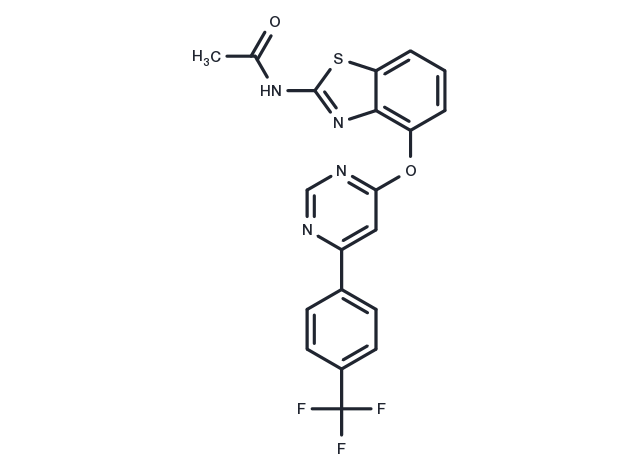Powder: -20°C for 3 years | In solvent: -80°C for 1 year


AMG 517 is an effective and specific TRPV1 antagonist, antagonizes proton (IC50: 0.76 nM), capsaicin (IC50: 0.62 nM), and heat activation (IC50: 1.3 nM) of TRPV1.

| Pack Size | Availability | Price/USD | Quantity |
|---|---|---|---|
| 5 mg | In stock | $ 47.00 | |
| 10 mg | In stock | $ 89.00 | |
| 25 mg | In stock | $ 197.00 | |
| 50 mg | In stock | $ 372.00 | |
| 100 mg | In stock | $ 556.00 | |
| 1 mL * 10 mM (in DMSO) | In stock | $ 52.00 |



| Description | AMG 517 is an effective and specific TRPV1 antagonist, antagonizes proton (IC50: 0.76 nM), capsaicin (IC50: 0.62 nM), and heat activation (IC50: 1.3 nM) of TRPV1. |
| Targets&IC50 | TRPV1(capsaicin):0.62 nM, TRPV1(heat activation):1.3 nM, TRPV1(proton):0.76 nM |
| In vitro | AMG 517 inhibits CAP- (500 nM), acid- (pH 5.0), or heat-(45 °C) induced 45Ca2+ influx into human TRPV1-expressing CHO Cells with IC50 of 0.76 nM, 0.62 nM and 1.3 nM. AMG 517 blocks capsaicin-, proton-, and heat-induced inward currents in TRPV1-expressing cells similarly. AMG 517 inhibits native TRPV1 activation by capsaicin in rat dorsal root ganglion neurons with an IC50 value of 0.68 nM. AMG 517 is a competitive antagonist of both rat and human TRPV1 with dissociation constant (Kb) values of 4.2 and 6.2 nM, respectively. AMG 517 is a highly selective TRPV1 antagonist. The IC50 value for AMG 517 is >20 μM against 2-APB-activated TRPV2 and TRPV3, 4-αPDD-activated TRPV4, allyl isothiocyanate-activated TRPA1, and icilin-activated TRPM8 in cell-based assays that measure agonist-induced increases in intracellular calcium in CHO cells recombinantly expressing the appropriate TRP channel. [1] |
| In vivo | Oral administration of AMG 517 produces a dose-dependent increase in plasma concentrations, it also produces a dose-dependent decrease in the number of flinches induced by capsaicin treatment. The minimally effective dose (MED), based on a statistically significant difference in number of flinches from the vehicle versus capsaicin-administered group, is 0.3 mg/kg for AMG 517. The corresponding plasma concentrations are 90 to 100 ng/mL for AMG 517. AMG 517 (3 mg/kg) exhibits significant reductions in capsaicin-induced flinch up to 24 h after dosing. AMG 517 blocks thermal hyperalgesia in CFA model of pain.[1] AMG 517 elicits hyperthermia in rodents, dogs and monkeys but not in TRPV1 knockout mice. Interestingly, hyperthermia evoked by TRPV1-selective antagonists is attenuated after repeated dosing of these antagonists to rats, dogs and monkeys, and TRPV1 knockout mice does not exhibit an impairment of thermoregulation.[2] |
| Synonyms | AMG517, AMG-517 |
| Molecular Weight | 430.4 |
| Formula | C20H13F3N4O2S |
| CAS No. | 659730-32-2 |
Powder: -20°C for 3 years | In solvent: -80°C for 1 year
DMSO: 43 mg/mL (100 mM)
You can also refer to dose conversion for different animals. More
bottom
Please see Inhibitor Handling Instructions for more frequently ask questions. Topics include: how to prepare stock solutions, how to store products, and cautions on cell-based assays & animal experiments, etc.
AMG 517 659730-32-2 Membrane transporter/Ion channel TRP/TRPV Channel AMG517 Inhibitor inhibit Transient receptor potential channels TRP Channel AMG-517 inhibitor
